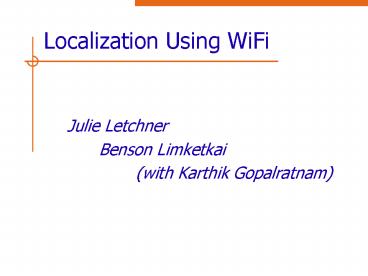Localization Using WiFi PowerPoint PPT Presentation
Title: Localization Using WiFi
1
Localization Using WiFi
- Julie Letchner
- Benson Limketkai
- (with Karthik Gopalratnam)
2
Introduction
- What is localization?
- Why is localization useful?
- Robotic applications
- Wider scope Assisted Cognition project
3
Traditional Robot Localization
- Object of interest robot
- Sensor laser range finder (LRF),
- sonar, camera
- Motion wheel encoders (well-defined model)
4
Particle Filter Basics
Motion model
Sensor model
Belief at previous time step
Normalizer
5
Particle Filter Basics
- Particle state ltx, y, headinggt
6
Access Points in Allen Center
7
Our Sensor Model
- Sensor observations radio signal strength
vectors - Where do these vectors come from?
- Attenuation models
- Direct measurement
8
Direct Measurement
9
Interpolated Signal Strength
10
Our Motion Model
- People move noisily and in no well-defined model
- Additional constraint voronoi graph
- New particle state
- Graph edge
- 1D position
- Gaussian velocity distribution
11
Allen Center Voronoi Graph
12
Setup
- Robot Pioneer 2 AT
- Control Saphira
- Signal strength
- readings Kismet
- Particle filtering
- Lin Liaos code
13
Experimental Results
- Data collected on different days / times
- Accuracy measured on the order of meters vs.
centimeters (LRF)
14
Training Data Results
15
Test Data Caveat Missing APs!
16
Test Data Caveat Missing APs!
17
Test Data Results
18
Conclusions
- APs were not designed for localization
- Extra software required for strength readings
- High redundancy required for accuracy
- Signal maps must be built explicitly by
measurement - Signal strength is highly variable
- Wireless card documentation is lacking
19
Future Work
- Attenuation models
- Signal interpolation methods
- Freespace constraints for non-corridor spaces
20
Bonus Track Human Data
PowerShow.com is a leading presentation sharing website. It has millions of presentations already uploaded and available with 1,000s more being uploaded by its users every day. Whatever your area of interest, here you’ll be able to find and view presentations you’ll love and possibly download. And, best of all, it is completely free and easy to use.
You might even have a presentation you’d like to share with others. If so, just upload it to PowerShow.com. We’ll convert it to an HTML5 slideshow that includes all the media types you’ve already added: audio, video, music, pictures, animations and transition effects. Then you can share it with your target audience as well as PowerShow.com’s millions of monthly visitors. And, again, it’s all free.
About the Developers
PowerShow.com is brought to you by CrystalGraphics, the award-winning developer and market-leading publisher of rich-media enhancement products for presentations. Our product offerings include millions of PowerPoint templates, diagrams, animated 3D characters and more.

